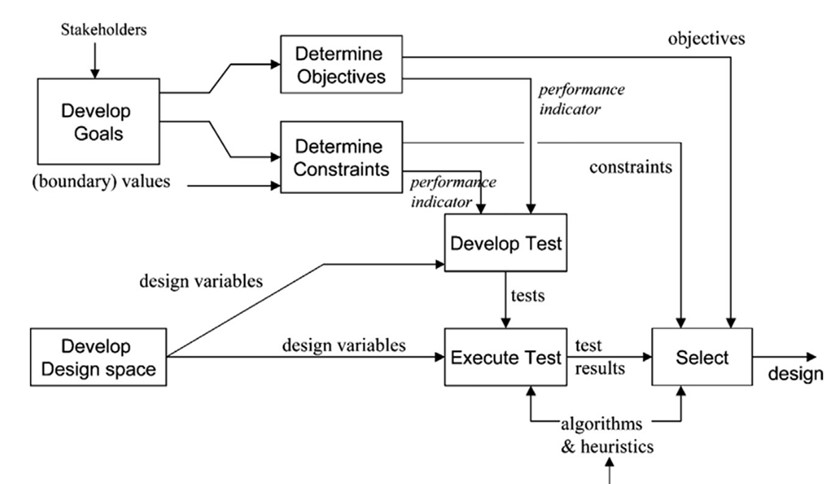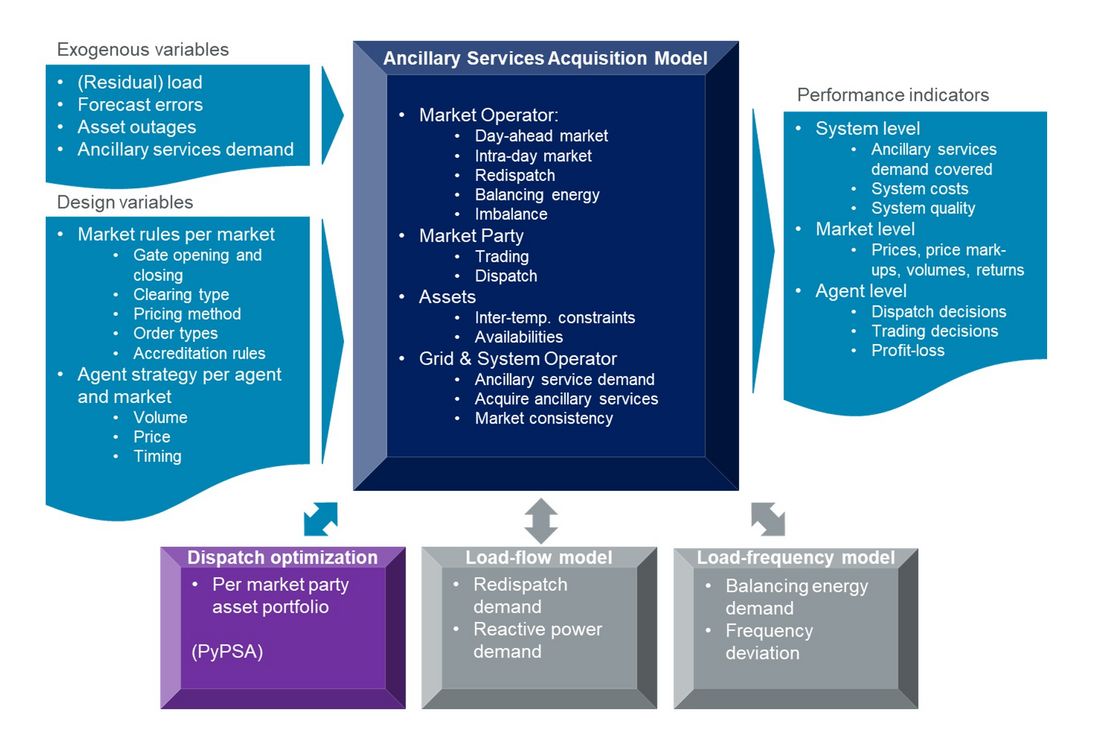Design challenge: How to evaluate the interaction of ancillary services?
The electricity sector is changing rapidly, where the main drivers of the development include climate change, interconnection of power systems and digitalization. Subsequent phenomena briskly materialize: increasing share of renewable energy sources, changing load patterns as well as demand response, new business models, and cross-regional power system coupling with increasing interconnection capacity. To cope with these developments, we need to rethink grid development, maintenance, and operation strategies. In this context, policymakers and engineers are also required to adapt existing ancillary services to ensure reliable operation of the electricity system.

M.Eng
Background
Ancillary services can be defined as “all services that system users provide to the system operator and the network operator for the operation of the transmission system and the distribution system” (Glismann and Nobel, 2017). Ancillary services are designed with the objective to control certain operational parameters, such as system frequency, balance of demand and supply, loading of grid components, or voltage. Next to the objective, an ancillary service requires a product specification (i.e. what service is delivered) and an acquisition process (i.e. how the service is obtained). These basic design elements are illustrated in Figure 1.

Figure 1 - Basic elements to structure design of ancillary services
(adapted from Glismann and Nobel, 2017)
From a service provider perspective (i.e. market party perspective), ancillary services are an opportunity (and sometimes an obligation) to market the flexibility of their generation, load, and storage facilities, in addition to the electricity (commodity) markets.
Challenges of ancillary service design
However, adapting ancillary services or adding new ancillary services in an adequate manner is a complex task. Adding a new and specific ancillary service for every emerging operational challenge and for every emerging provider technology would not lead to an appropriate design of the ancillary services landscape. Such narrow proposals ignore a number of challenges regarding ancillary services:
- A large plurality of ancillary services makes it difficult for market parties to understand for which ancillary service to offer their flexibility and how to determine their risks as well as subsequent offer prices.
- An ‘overfull toolbox’ for grid and system operators is difficult to use in a manner that is cost-efficient, fair and transparent. For example, (academic) concepts proposing operator utility functions to optimize the services’ procurement have a general weakness: Utility functions require an expression of willingness-to-pay per operational issue (e.g. frequency deviation and grid congestions), which is not trivial in daily operations. Hence, it is questionable if such approaches would lead in practice to a secure operation at minimum cost.
- A changed design of one ancillary service may successfully increase the supplied quantities or reduce offered prices; however, it may at the same time ‘cannibalize’ the liquidity of another ancillary service. Subsequently, system operation costs may increase and additionally lead to unsolvable operational issues due to missing offers.
- Cross-regional ancillary service procurement is generally challenging, as consumer tariffs, subsidies, and taxes may differ per jurisdiction. Furthermore operator remuneration can also differ (e.g. transmission system operator versus distribution system operator remuneration). However, many specific ancillary services per region further increase the complexity of interactions and lead to scattering of flexibility supply.
Consideration of these challenges is important for ancillary services design in order to avoid unwanted side-effects.
Two examples to illustrate the importance of interaction evaluation
Many studies assess possible ancillary services solutions regarding inertia issues, which are expected to increase as a consequence of phasing-out coal-fired and gas-fired power plants. One option would be a fast frequency response service; another option would be an inertia availability service (i.e. rotating mass). However, both options may attract providers of the existing frequency containment reserve (FCR) market in EU context. Given this potential interaction, is it better to add one of the options to the existing ancillary services or should the FCR market be replaced?
A second example concerns the interaction of ancillary services for balancing and for solving grid congestions. Redispatch shifts electricity generation or consumption in order to mitigate overloads. The service provided by grid users is a change of dispatch at a specific location (Hirth and Glismann, 2018). However, when the sum of acquired redispatch services at a time period is not ‘energy neutral’, the grid operator induces imbalance to the system. This imbalance from ‘incomplete’ redispatch impacts the activation of balancing energy services and ultimately affects the imbalance prices. The example shows that the design choices of redispatch services may cause balancing issues and affect the incentives of the balancing market.
Design evaluation methods
Explicitly choosing a scope of assessed ancillary services is the first design evaluation step when considering interactions of ancillary services and electricity markets. The following questions may be helpful:
- What are the ancillary services with the same objective as the examined ancillary service?
- Which ancillary services were (historically) provided by the same potential providers of the examined ancillary service?
- Which markets are operated in parallel or after the examined ancillary service?
- Are opportunity costs in preceding markets (significantly) affected?
Yet, there are not many common methods for evaluating ancillary services interactions. However, literature shows methods such as generic design process application (Figure 2), expert interviews, and multi-criteria analyses (see e.g. Doorman and van der Veen, 2013).

Figure 2 - Generic conceptual design framework from (Herder and Stikkelman, 2004)
Agent-based modelling is another approach to investigate interactions of markets and services, although not that common among engineers. The advantage of agent-based models lies in the following features: (1) designs can be tested with imperfect behaviour as well as self-learning of simulated agents; (2) agent-based models can incorporate various market models as well as physical power system models (e.g. load-flow models and load-frequency control models), and they can combine different ‘classical’ optimization methods. Examples are the design “test-bed” for U.S. power systems called AMIS (see for more information Tesfatsion, 2018) and the Ancillary Services Acquisition Model (ASAM) for EU context (see for more information Glismann, 2021). ASAM is illustrated on Figure 3.

Figure 3 - Overview of ASAM functionality from Glismann (2021)
A few design recommendations
Lastly, ancillary service design is not only about operational security at efficient cost but also about cost-benefit distribution. In practice, it involves policy making processes with many involved stakeholders and institutions. Therefore, next to the inherent complexity of ancillary services interactions, the variety of stakeholder interests adds complexity to the design process. In this light, the author recommends a few principles for ancillary services design in practice:
- Keep the design simple and robust, instead of optimizing cost efficiency.
- Minimize the necessity for ancillary services in the first place by a long-term system design with sufficient grid investments and high grid connection requirements.
- Select a few ancillary services per objective (small toolbox).
- Standardize ancillary services (products and procurement processes) across regions, and harmonize tariffs, taxes and subsidies.
Bibliography
- Doorman, G. L. and van der Veen, R. (2013) ‘An analysis of design options for markets for cross-border balancing of electricity’, Utilities Policy, 27, pp. 39–48. doi: 10.1016/j.jup.2013.09.004.
- Glismann, S. (2021) ‘Ancillary Services Acquisition Model: considering market interactions in policy design’. Pre-print of Applied Energy research paper. Available at: https://arxiv.org/abs/2104.13047.
- Glismann, S. and Nobel, F. (2017) ‘A framework for ancillary services design’, in International Conference on the European Energy Market, EEM. doi: 10.1109/EEM.2017.7982008.
- Herder, P. M. and Stikkelman, R. M. (2004) ‘Methanol-Based Industrial Cluster Design: A Study of Design Options and the Design Process’, Industrial & Engineering Chemistry Research, 43(14), pp. 3879–3885. doi: 10.1021/ie030655j.
- Hirth, L. and Glismann, S. (2018) Congestion Management: From Physics to Regulatory Instruments, ZBW – Leibniz Information Centre for Economics, Working Paper. Available at: http://hdl.handle.net/10419/189641.
- Tesfatsion, L. (2018) Electric power markets in transition: Agent-based modeling tools for transactive energy support, Handbook of Computational Economics. Elsevier B.V. doi: 10.1016/bs.hescom.2018.02.004.
Thumbnail credit: Photo by Joakim Honkasalo on Unsplash - Oil Silo 468 in Helsinki

